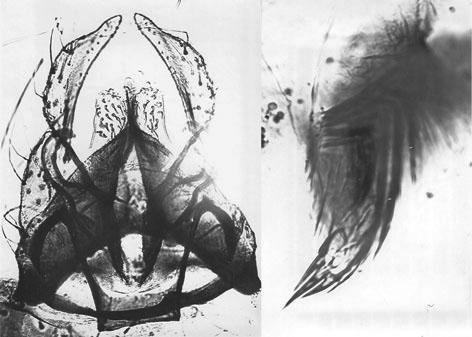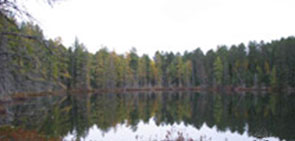Species h. Similar to C. decumbens but may be new species.In BOLD Bin: BOLD:AAP3010
(Mined from GenBank KF278349 - see below)Adult: There are at least 4 adult males in the collection of J. E. Sublette, in the Museum of the University of Minnesota, or in the collection of the Canadian National Insect Collection in Ottawa. Male: Only a photograph of the male hypopygium is available.
Male terminalia (left) and pupal spur (right) of C. sp. h.Anal point slim. A small number of setae in pale circles on tergite IX. Superior volsella of E-type(j) of Strenzke (1959), Inferior volsella to about the tip of the narrow anal point, gonostylus narrowing relatively sharply over posterior quarter. Female - not known. Pupa: Caudolateral spur of segment VIII with about 4 closely spaced spines, but with other fine spines on base to the spine, particularly on the inner side (see figure above). Fourth instar larva of the plumosus type, medium to large size (fem. 15-17.5 mm; male 10-16.7 mm), lateral projections from 130-260 µm). Anterior pair of ventral tubules usually longer (ant. 0.79-1.60 mm; post. 0.72 - 1.3). Anal tubules long (1.06-1.52 mm), about 3.8-6.4 times longer than wide, ventral possibly longer; apparently longer in deeper water.
Gular region usually darkened on posterior third to half with slight wing-like extensions but may be pale; and frontoclypeus pale or slightly darkened.
Mentum (Fig.b)with pointed teeth; c1 tooth broad, possibly with a flanged edge, c2 teeth moderately seperated but tend to continue edge line of centre tooth (type IB); 1st laterals sloping outwards, 4th laterals reduced almost to level of 5th laterals (type II).
Ventromentum about 3.5 times longer than deep, with about 44-49 striae reaching almost to anterior margin; VMR 0.25. Pecten epipharyngis with about 13-14 sharp, broad teeth (type B).
Premandible (Fig. b) with teeth about equal in length, inner tooth about 2.5-3 times wider than outer tooth.
Distance between antennal bases about the same as that between the S4 setae, which are separated by about 77-81% of frontoclypeal width at that point.
Antenna (Fig. a) long 3.5-4 times longer than wide, RO about 2/5 to 1/2 up from base of A1; AR about 2.04-2.09; A2 about 0.25 the length of A1; segment lengths (µm) 145 : 37 : 10 : 15 : 8.
Mandible (Fig. d) with 3rd inner tooth distinct but only partially colored (type II –IIIA/B); about 19-21 furrows on outer surface near the base; 12-14 taeniae in Pecten mandibularis. Cytology: 4 relatively short polytene chromosomes with the thummi arm combination AB, CD, EF, G. Centromeres markedly heterochromatic.
Arm G very short, bands indistinct and normally only paired at the almost terminal nucleolus. Nucleoli also in arms B, C, D (2 or multiple nucleoli) and F.
Arm A1: 1a-e, 2d-3i, 12c-10a, 2c-1f, 9e-4a, 13a-19f(?) possibly as atrella A1
(could be 1-2c, 10-11? 9, 2d-3, 12, 8-4, 13-19)
Arm B1: 1-?, 20-18, ?, 9(?)-13, ?-8b, 17-14, 23-28 i.e. derived from heteropilicornis
Arm C1: Nucleolus about one third from centromere.
Arm D1: Nucleoli near middle of the arm.
Arm E1: 1-3e, 5-10b, 4-3f, 10c-13 ie. as aberratus
Arm F1: 1, 9-1g, 13-23(?) Nucleolus about group 15.Arm G1: Virtually terminal nucleolus. Found: North West Territories - Cache Lake, Tuktut Nogait National Park (from BOLD)
Ontario - Bat Lake (45.577°N, 78.523°W), Algonquin Provincial Park, Nipissing Co.
Bat Lake, Algonquin Provincial Park, OntarioAmongst deep organic litter in a highly eutrophic lake.This species shows clear relationship to C. islandicus: they have a similar SVo; arm G is small and lacking a nucleolus, with multiple nucleoli on the long chromosomes some of which appear to correspond. It also shows relationship to C. ?decumbens, which also has a small arm G and multiple nucleoli. DNA sequence
mtCOI - in BOLD, also GenBank accession no. KF278349 (see Proulx et al. 2013) See also C. decumbens(?) | C. islandicus[ Return to Index ] |

